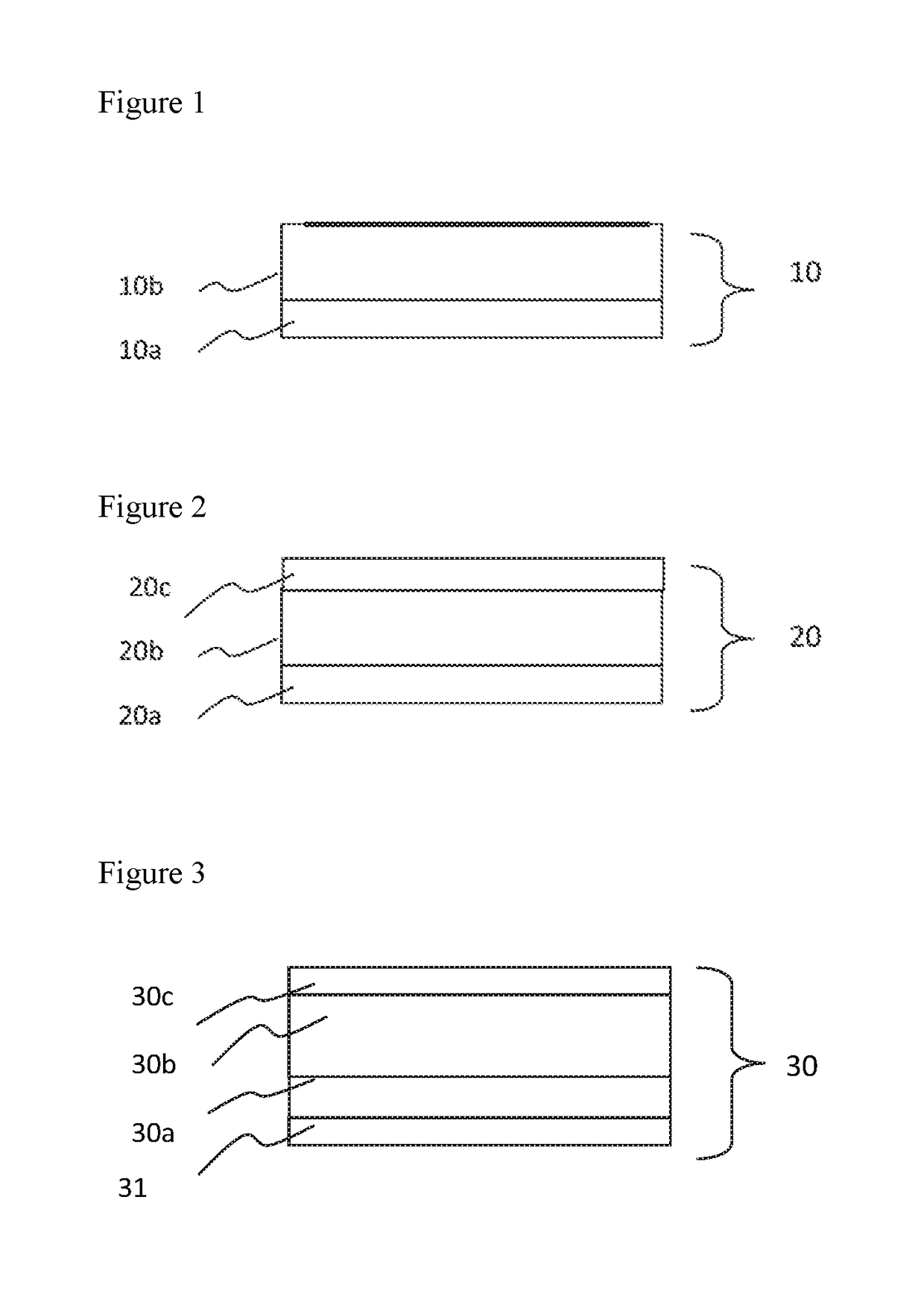Monoaxially or biaxially oriented polyolefin release film
a polyolefin and release film technology, applied in the direction of synthetic resin layered products, coatings, chemistry apparatuses and processes, etc., can solve the problems of unsuitable for many end-uses, further downstream processing problems, and high cos
- Summary
- Abstract
- Description
- Claims
- Application Information
AI Technical Summary
Benefits of technology
Problems solved by technology
Method used
Image
Examples
examples
Raw Materials
Crystalline Polypropylene Homopolymer Resins:
[0042]LX11306 from Total Petrochemical, having Melt Flow Index (measured at 230° C. under a weight of 2.16 kg) of 2.0 g / 10 min.
[0043]H03BPM from NATPET (National Petrochemical Industrial Co.) having Melt Flow Index (measured at 230° C. under a load of 2.16 kg) of 3.0 g / 10 min.
Poly-4-Methyl-1-Pentene (“PMP”) Resin:
[0044]TPX™ MX004 from Mitsui Chemical with Melt Flow Rate 25 g / 10 min measured at 260° C. under a load of 5 kg.
[0045]Olefin Copolymer elastomer (High α-olefin-content random copolymer).
[0046]Tafmer™ A4085S (ethylene / 1-butene random copolymer made with metallocene catalyst) from Mitsui Chemicals, having melt flow rate (at 190° C. under a load of 2.16 kg) 3.6 g / 10 min and a density of 885 g / cm3, and a melting point of 66° C.
[0047]Tafmer™ A4070S (ethylene / 1-butene random copolymer made with metallocene catalyst) from Mitsui Chemicals, having melt flow rate (at 190° C. under a load of 2.16 kg) 3.6 g / 10 min, a density of ...
example 1
[0063]The film-making procedure of Comparative Example 1 was repeated but with Tafmer™ present in the skins and with 50% TPX™ present in the skins as well; the layer compositions were as shown in Table 1. The same properties as in Comp. Example 1 were tested and shown on Table 2. As indicated by comparing the properties of Example 1 vs. Comp. Example 1, the addition of 10 wt % Tafmer™ elastomer in the PMP-containing release layer of Example 1 eliminated the delamination issue experienced in Comp. Example 1 upon tape release. Comparing the gloss and roughness ratings (and also visual observation) shows that the presence of Tafmer™ elastomer also produced a rougher surface and almost matte appearance, especially on the surface side of layer A where the presence of Tafmer™ elastomer (layer A blend) is higher. Finally comparing the release force (tape peeling force) between sides A (layer A blend) and side B (layer C blend) resulted in differential release properties between the two ski...
example 2 (
Tafmer™ in Skins)
[0064]The film-making procedure of Example 1 was repeated but with a higher level of TPX™ and a lower level of Tafmer™ in the skins. the layer compositions were as shown in Table 1. The A-side testing results (tape peeling force) indicate the lowest peeling strength amongst the examples, resulting from maximizing TPX™ content. At the same time, surface gloss is higher and surface roughness is lower than Example 1, correlating with the lower Tafmer™ content in the skins.
[0065]Example 3 (Tafmer™ elastomer plus hard-coat inline coating). The film-making procedure of Example 1 was repeated but in addition there was inline coating (between the MDO and the TDO section, a gravure coater is used to apply an aqueous hard-coat composition based on acrylic resin NeoCryl® A-1127 of 44% NVS (non-volatile solids) upon the outer surface of the extruded skin layer A. This coating is then dried and oriented transversely in the stenter oven to form a dried coating of ca. 0.10-1.0 um ...
PUM
| Property | Measurement | Unit |
|---|---|---|
| wt % | aaaaa | aaaaa |
| wt % | aaaaa | aaaaa |
| melting point | aaaaa | aaaaa |
Abstract
Description
Claims
Application Information
 Login to View More
Login to View More - R&D
- Intellectual Property
- Life Sciences
- Materials
- Tech Scout
- Unparalleled Data Quality
- Higher Quality Content
- 60% Fewer Hallucinations
Browse by: Latest US Patents, China's latest patents, Technical Efficacy Thesaurus, Application Domain, Technology Topic, Popular Technical Reports.
© 2025 PatSnap. All rights reserved.Legal|Privacy policy|Modern Slavery Act Transparency Statement|Sitemap|About US| Contact US: help@patsnap.com



